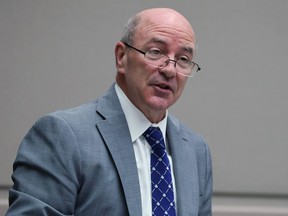Coun. Peter Demong said the city needs a better strategy when determining how to allocate unexpected surplus revenues.

Article content
A Calgary councillor is hoping to end an almost annual debate that occurs in city council chambers — what to do when the city receives an unexpected surplus from one-time revenue sources.
Ward 14 councillor Peter Demong intends to introduce a three-part notice of motion at Tuesday’s executive committee meeting, including a pitch to come up with a better policy for handling unbudgeted operating variances.
Advertisement 2
Article content
Article content
“We’ve had some unusual variances with regards to one-time-only funding,” Demong told reporters on Thursday, referring to revenues from the local access fee (LAF) and Enmax dividend.
“I’d like us to take a look at what we’ve done with those, make sure we lay them out in a very proper manner to decide if we dealt with them properly, efficiently.”
Due to a unique formula that ties its LAF to Alberta’s regulated rate option price of electricity, the City of Calgary has received huge revenue windfalls from the levy in recent years thanks to skyrocketing power prices, which reached record highs of nearly 32 cents per kilowatt hour last summer.
Enmax’s financial figures show the city collected $303 million from the LAF in 2023, despite only budgeting to receive $125 million.
In September, council approved to review the city’s LAF formula as a result of that anticipated surplus.
But in December, councillors voted to defer their decision until the provincial government completes a review of the regulated rate option this spring.
The city needs to have a better plan in place to allocate unexpected surplus revenues in a more efficient manner, Demong said, rather than the status quo of council debating annually how to spend the money.
Article content
Advertisement 3
Article content
What that plan ultimately includes remains to be determined. Demong said ideas floated in the past included rebates, stashing the surplus cash in a reserve, or using it as one-time funding.
“Are there going to be one-off situations that we have to deal with on an annual basis?” he said. “Yes, absolutely, but if we can lower the amount of discrepancy on how to deal with them, that would be the plan I’d like to see moving forward.
“When you have variances, you should have plans to deal with them — that’s all I’m really suggesting.”
Municipal-provincial communication needs to improve, says Demong
The other part of Demong’s notice of motion includes measures to improve communication between the city and the provincial government.
He argues the Alberta government has not only reduced the capital and operating funding the city receives annually, but has also downloaded provincial responsibilities like housing, emergency response and mental health programming onto municipalities.
This has all come as Calgary experiences tremendous population growth and inflationary pressures, which Demong said aren’t appropriately factored into the province’s Local Government Fiscal Framework — the mechanism that allocates funding to Alberta’s municipalities for infrastructure improvements.
Advertisement 4
Article content
“As a city councillor, there are a lot of pushes and pulls that are happening that I don’t think the province is completely understanding of,” said Demong, who is one of Calgary’s two representatives on the ABmunis (Alberta Municipalities) board of directors.
“If we’re in this together, how do we deal with the Calgary area bringing in the equivalent of a Medicine Hat population every single year?”
His motion would direct city staff to engage with Municipal Affairs to discuss their response to the city’s recent Municipal Funding Gap report, which highlighted an annual shortfall of $311 million in capital and operating funding from the Alberta government.
“It’s a conversation I believe we need to start having on a regular basis, because in many ways, I feel we’re not listening to each other,” Demong said.
“How can we combine our powers between the province and the municipalities to better serve Albertans?”
As a notice of motion, Demong’s proposal will first have to undergo a technical review at Tuesday’s executive committee meeting. If it receives endorsement from the committee, the motion would advance to a regular city council meeting for a debate of its merits.
Article content



